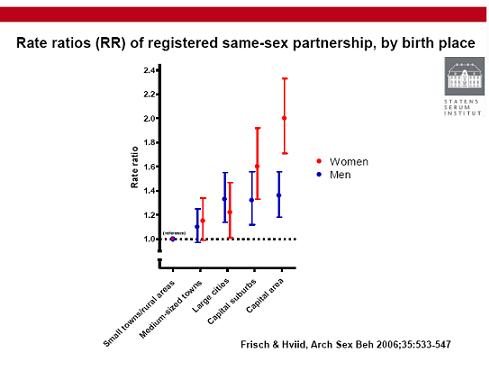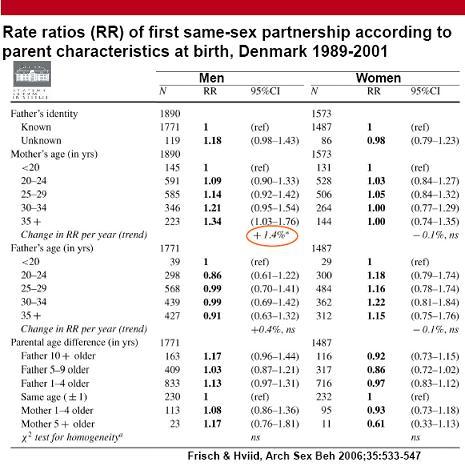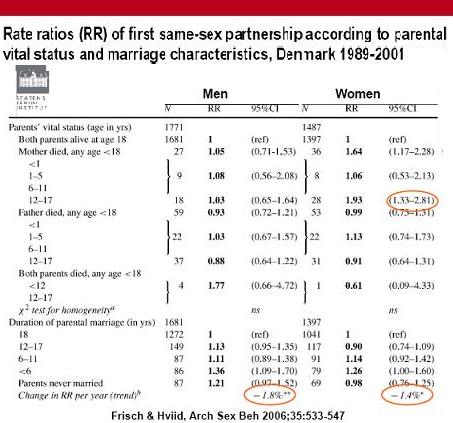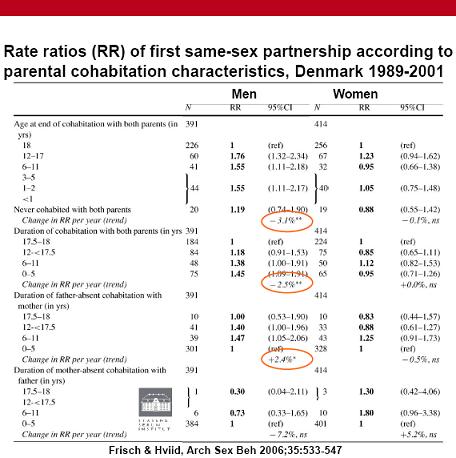I was talking to an acquaintance who attended a Journey into Manhood weekend. He was disappointed that his attractions to the same sex did not evaporate after the weekend. To be sure, he felt a greater sense of masculinity and much less self-conscious. During the first week or two after the weekend, he seemed to notice women more and did not feel the usual tug to look at gay porn. However, after awhile he noticed something unexpected. At what he felt was the height of his feelings of security about his manhood, he again experienced same-sex attractions. At that point, he began to feel an assault on his sense of manhood. In other words, instead of the sense of diminished masculinity leading to same-sex attraction, it was the other way around. His awareness of same-sex attraction came first and then his reduced sense of himself as a male.
I have noticed this before in the stories of men who describe SSA. The awareness of same-sex attraction in their early years (elementary school, junior high) came prior to struggles over masculinity. I guess once this association is made, one could trigger the other. I wonder if this kind of association is what makes the masculinity enhancing weekends so attractive to reparative therapists.
I see no or little benefit from them on either front although some men, straight and gay, believe they have been helpful. The New Warriors Training Adventure, recommended to SSA men by Richard Cohen and Joseph Nicolosi, rarely alters SSA even though many gay males say that they feel much better about themselves as men after involvement in them.
Category: NARTH
Digest: Moon, Obama, Cohen, Povia, Weinland
I have been looking into several things of late, some of which may develop into a post. For now, I’ll just a few spots (not sure if they are high or low, maybe just strange).
-According to Unificationist websites, Barack Obama has been friendly with Sun Myung Moon front groups, the American Clergy Leadership Conference and True Family Values since before Obama became a Senator. One highly placed Moon follower and official related that Obama’s wife may be involved in Unificationism in some way. See this page for more on that topic.
-Speaking of Unificationism, Richard Cohen’s interview on Universal Peace Television (MoonTV) appears on the Unificationist YouTube account of Kevin Pickard (UPDATE: Scrubbed within 30 minutes of the post, see below). Also, Cohen has been active on YouTube of late with account IHF2008. Looks like he is putting the archives up for view with past appearances on O’Reilly Factor, Paula Zahn, Larry King and local news. I wonder if we will see his appearances on Jimmie Kimmel, the Daily Show and the 2006 Paula Zahn Show?
-We had an English translation of Luca Era Gay here, if not first, pretty close to it. Now, You can listen to it on YouTube. It is kind of catchy…
-Did you know that nuclear explosions might rock the US by March? If you are a follower of Ronald Weinland, you are getting ready for the end times. He claims to be one of two end time prophets with the Kingdom coming in by 2012. If you are interested in how religiously-based mind control groups operate, you can read a bit on this discussion blog for those who are believers in Weinland and those who are on the fence.
That is an odd lineup…
UPDATE: In what is the quickest scrub job I can recall, the Cohen video has already been taken down from Kevin Pickard’s YouTube page. Here is a screen capture of the page and the video from a couple of days ago. I suspect next will be the same interview on Universal Peace Television.
Can we infer the past from the present?
(This post has been moved up and republished)
For the foreseeable future, posts about topics related to my book-in-progress will come up frequently, punctuated with articles regarding my new medical interest – PANDAS. The book relates to same-sex attracted people who are in heterosexual marriage. There will be a significant section on theories regarding sexual orientation.
In that section, I will take up the problems of reparative drive theory and as such critique the primary means of gathering data for the theory – clinical experience. Reparative therapists base their formulations, not on several lines of empirical research, but on reconstructions from clients. This post will be a series of quotes from a 1984 book by psychotherapist Morris Eagle, titled, Recent Developments in Psychoanalysis: A Critical Evaluation and published by McGraw-Hill. In the section, I am referencing (131-140), Eagle begins:
I have noted above that according to most current writers, the essential factor in the etiology of developmental defects and arrests is early trauma of some kind…I have already noted (and will discuss again later in this chapter) that there is little or no evidence for these etiological claims.
Eagle believes that then current (in the mid-1980s and represented now by reparative therapists such as Joseph Nicolosi and Richard Cohen) psychoanalytic theorists miss the move Freud made from seeing the patients problems steming from actual trauma to intrapsychic conflict. Freud confronted the question regarding the veracity of his patients stories and concluded with varying degrees of conviction that the stories did not of necessity represent real events but rather patients’ mental constructions.
Eagle criticizes this view of etiology, saying:
In other words, what is invoked in the etiology of pathology is not intrapsychic conflict, personal meanings and fantasied interpretations of ostensible events, but the direct effects of supposed actual events (usually maternal failure – e.g., lack of empathic mirroring – of some kind) upon psychological development, relatively unmediated by personal fantasies and meanings. This kind of etiological explanation is similar in form to early Freud’s seduction theory and to pre-psychoanalytic accounts. It is a straightforward A causes B account, much as one would say that lack of vitamin D (A) causes rickets (B). (author’s emphasis)
To explain same-sex attraction, reparative drive theorists assert a set of developmental failures primarily involving the same-sex parent. These events are considered to be directly causative. What else can make of statements like this?
The child was not supported by his parents in his early masculine strivings, and as an adult, he is now in conflict with his normal desire to connect with other males.
A significant number of our clients report a family background which could be defined as narcissistic. In the narcissistic family, the child is placed in the communications structure of the Double Bind, or the “no-win predicament.” If he assumes responsibility for the fact that he does not feel loved for who he really is, the child is rewarded with parental love and attention (but of a narcissistic and malattuned sort). That is the nature of shame-assuming responsibility for “not having been lovable.” However, if he maintains his assertive stance, holding onto the integrity of his own perception and his own his internal state, he is punished with parental inattention and withdrawal.
To comprehend the profound gravity of this choice, we need to understand what we mean by a parent’s well-intentioned but malattuned love. When one is a very small child, parental malattunement feels like a profoundly painful expulsion, a “shunning” that is experienced as nothing less than hopeless abandonment. The price of choosing to maintain his own perception means, to the small child, having to confront the primal fear of abandonment-annihilation.
In the case of reparative drive theory, the parental failure comes from both parents – father gets a role in this psychoanalytic story. Eagle does not use the term confirmation bias but he notes the peculiar tendency of psychoanalytic theorists to ascribe meaning to historical events according to the analyst’s theories.
…so-called defects and arrests are not necessarily transparent rather involve the theoretical interpretation and judgment that certain behaviors are expressions, often indirect and subtle ones, of underlying developmental defects and arrests. What follows is that if one’s theoretical predilections are in a particular direction, one can view a particular set of behaviors as indications of a self-defects and developmental arrests, while someone with a different theoretical inclination will give a different diagnostic meaning to these behaviors…as Rangell (1980) has noted, the kinds of patients described as narcissistic personality disorders and as suffering from self-defects by Kohut and his followers have long been observed by many analysts who viewed them as neurotic rather than as warranting a distincy diagnostic category.
Searching for critical relational wounds (“bad enough parents”) has treatment consequences which Eagle believes leads to impossible expectations. Some people come in with clear knowledge of their history and desires to resolve their relationship to that history. Therapists should work with clients in this manner. However, some therapists press clients to adopt an explanatory framework which does not fit, or only fits with significant distortions or reconstructions.
Eagle questions the utility of suggesting to clients that their symptoms are tied in some direct manner to events, especially those before awareness. Can therapy really allow a person to go back and repair developmental arrests in any meaningful, real world way?
Many recent conceptualization of therapy suggest that treatment compensates for early traumas and the deficiencies they bring about. I have referred to this elsewhere as a “deficiency-compensation” model of therapy. However, it is likely that the salutary effects of therapy have mainly to do, not with eliminating developmental failures and structural defects, but with ameliorating the effects of the unrealistic anxieties and unresolved conflicts typically accompanying whatever failure or defects are one’s lot (author’s emphasis).
I share Gedo’s (1980) skepticism toward talk about resumption of developmental growth and the claim that psychotherapy somehow directly repairs developmental impairments and structural defects…As adults, we are not simply frozen at “arrested” points in childhood. Hence it is not at all clear as to what is meant by permitting arrested configurations to unfold as they would have when we were 1,2, or 3 years of age. What can such talk mean or refer to?
Eagle doubts that the benefit of therapy derives from the analyst and patient repairing the past via the present relationship. In this context, I am reminded of Richard Cohen’s justification for holding therapy on CNN – “It establishes a parent-child relationship. He didn’t get this from his own dad.” Being emotionally present for a client is important to serve present day functions but there is little evidence that therapeutic attunement in itself repairs historical deficits. He continues with this money quote…
The emphasis on early periods of development has led to unbridled speculations regarding supposed events and processes in infancy and childhood. Such speculations are often of an etiological nature or may simply refer to what presumably goes on in early development. What they all have in common is that, remarkably enough, they are entirely based on clinical work with adult patients and make no reference to empirical studies with infants and children, let alone long-term longitudinal evidence.
I probably should have led this post with this point. If you have read this far, this is a reward for doing so. Any theory that relies on the reconstructive memory of clients to open the door to the past should be doubted and pressed for confirming evidence. Critical events in reparative drive theory are proposed to occur prior to the age when most people can hope to recall (18 months to 3.5 years). The belief in their occurance comes from client reconstructions – a very selective sampling and subject to the therapist’s confirmation bias.
Eagle quotes Rubenfine (1981) with this caution:
under no circumstances are we ever justified in using our creative fictional ‘constructions’ about origins of pathology in the first year of life to serve as data for theorizing about early childhood development.
In short, given the reconstructive nature of memory, we cannot infer the past from the present with the kind of precision needed to craft dogma. Eagle has provided a solid critique of reparative type therapies which compel clients to emotionally relive the past and seek repair with an empathic therapist. Clearly, some good comes from these efforts, but, with Eagle, I suspect the empathy establishes the relationship and any good comes from present day strategies clients learn to navigate present life as adults.
Frisch & Hviid and reparative drive theory revisited
Commenter Evan recently posted a link to a informative powerpoint produced by colleague Morten Frisch regarding his study of social and family factors associated with homosexual and heterosexual marriage in Denmark. Morten is no stranger to this blog as he commented at length regarding the Cameron’s biased attempt to estimate homosexual lifespans. I reviewed this study for a Washington Times article (the WT link is disabled but it is here)and believe it is a significant contribution to the literature regarding causal factors associated with sexual orientation.
I would like to look at the significant findings in Frisch’s study in relationship to predictions made by reparative drive theory. According to the powerpoint, the purpose for the study was
To use a unique national set of demographic data free of selection bias to
-identify possible childhood family correlates of adult sexual orientation and partner choices
-evaluate the fraternal birth order (FBO) hypothesis (Blanchard) for male homosexuality
Regarding the latter purpose, the study found no evidence to support the FBO. What I want to do now is reproduce a few of the slides in light of predictions from reparative theory. Reparative theory proposes that disruption in the same-sex parent relationship in the crucial years of gender identity formation is responsible for homosexuality as a “gender identity problem” (Joe Nicolosi used to call homosexuality a gender identity disorder). His newer iteration of the theory refers to male homosexual “enactment” as deriving from feeling cut off from authentic masculinity. This deficit is located in a failure of the boy to successfully disidentify with mother and identify and bond with father between 18 and 36 months of age. Rejection from male peers builds on the bonding failure resulting in an eventual experience of same-sex attractions in a false and futile effort to return to masculinity. He has less to say about female homosexuality and most reparative therapists say that just about anything can lead to lesbianism as long as it is traumatic in some way or a deficit of upbringing.
Based on these premises, we would expect research on large groups of homosexuals to show an increase in problems during those crucial periods of early childhood. Further, we would expect the differences between groups to be large since reparative therapists say that the environmental experiences are necessary causes of same-sex attraction. With this in mind, let’s look at the Frisch results.
Birth place and marriage

On all of these tables, one (1) is the baseline and deviation from one is considered to be an increase or decrease in likelihood of homosexual partnership. In this case, the likelihood of same-sex partner choice goes up with the urbanicity of birth place. It is hard to know what this means. One might suppose that attitudes toward same-sex marriage are more liberal in the urban area if one assumes people are married where they are born. In a smaller country like Denmark, it seems that gay people in the rural areas might just move to the city where attitudes are more accepting. Perhaps, the social attitudes in the area where one grows up plays a role as well.
Parental characteristics

First note that none of the variables here are significant for women and only one is for men – mother’s age. There is a slight increase in odds of homosexual marriage for men if one’s mother was over 35 at birth. I do not see any clear theoretical connection for this finding. However, apropos to this post, note that awareness of the identity of one’s father has no significant impact on marital direction. A reparative paradigm would expect disruptions or ambiguity of paternal identification to lead to an increase in homosexual partnering.
Parental vital status and marriage characteristics

Reparative theory would predict disruptions in the same-sex parent bond in early childhood. As indicated by parental death, Frisch does not find the predicted disruptions. First of all, such circumstances for men or women are infrequent (only 22 cases each of paternal death before age 11) and second, there is no relationship to partnering in males. In females, the relationship to partnering is not in the early childhood years but during adolescence. As with all of these differences, the effect size is quite small so the variable does not account for much variation between gay and straight partnering.
Regarding parental marriages, I am a bit unclear how this finding relates to reparative drive theory. I initially wrote that there is a very small effect of short parental marriages for both men and women. However, I asked Morten to read this summary prior to publication and he took some exception to this point. He wrote,
Actually, there is a 36% higher likelihood of same-sex marriage among boys whose parents’ marriage lasted less than 6 years compared with boys whose parents’ marriage remained intact until age 18 years, and the corresponding estimate was 26% higher same-sex marriage rates among girls whose parents’ marriage lasted less than 6 years compared with girls whose parents’ marriage remained intact until age 18 years. Our data on duration of parental marriage duration and, for boys, duration of father-absent cohabitation with mother obviously don’t prove anything in relation to the reparative theory, but they are not in conflict with it.
On the other hand, effect sizes calculated in the way I am used to seeing finds a trivial amount of variance.
The only marriage duration that related to homosexual marriage was the “less than 6 years” category.” It would be tempting to see this as meaning that the children were all under 6. However, in Denmark, it is not uncommon for couples to cohabitate, have a child and then get married. In other words, we cannot assume the ages of the children involved based on duration of marriage.
In any event, this finding, even if of some substance, would neither confirm nor disconfirm the specifics of reparative drive theory – especially in light of the data which do not find a push toward homosexual partnering among males who experienced father absence due to death or unknown identity.
Parental cohabitation

This slide depicts data which seems more promising for a reparative theorist in that father absent cohabitation shows a slight relationship to partnering for males. However, if I was a reparative drive theorist, I would be disappointed. First, the number of gay males who experienced this factor is relatively small (80 of father absent cohabitation of between 6-17.5 years). Most partnered gays did not experience this event. Second, the effect is very small. If same-sex parent disruption was a necessary condition, might expect more dramatic results with application to both sexes.
I find myself in the unusual position of qualifying Morten’s conclusions. I think there is a need to qualify the factors by the non-significant results found. For instance, Morten lists father absence as a factor related to gay marriage. However, I would note that paternal absence via death was unrelated to outcome as was lack of knowledge of father’s identity.
On balance, I do not think Frisch and Hviid’s massive study of marriage choice provides significant support for reparative drive theory. If anything, the predicted findings are mixed.
If parental bonding and was massively and necessarily related to homosexual outcomes, it seems that some large study would find greater differences on the relevant dimensions. However, neither the recent Francis study nor the Wilson and Widom study of abuse and neglect demonstrate the expected results. While Frisch and Hviid report some impact of marital disruption, it is unclear what is the potent element of those events.
Gay children: Is it the parent's fault?
Crosswalk.com today published an article I wrote regarding the issue of causes of same-sex attraction. In it, I describe several problems with reparative drive theory as a general explanation for same-sex attraction. You can go there to read the entire article, but I want to post an email from a couple regarding their experience with the failure-to-bond idea. This segment is also in the Crosswalk article.
As parents of a same-sex-attracted son, there was no mountain too high for us to connect our son and our family to the “best help” for our issues. We found a counselor for him, and then joined him in many sessions and spent a good deal of time examining our parent – child relationships; classifying them as “close” or “distant” and figuring out why. With our broken hearts on the table each week, we looked for the magic thread, the exact moment we disabled our son’s sexuality so as to examine it, repent of it, be forgiven and put this nightmare away. Our counselor finally admitted that we were “unique” and that our son was “unique,” not fitting into the usual (how does the term “usual” apply to sexually fallen humans?) categories and that he basically did not know what else to say to help to untangle these conflicts for our son. We went on to read many books, we attended a famous conference 1000’s of miles away from our home, only to meet one of the most famous authors whose flippant response to us upon introducing ourselves to him was “Yes – I can see it, the mother who did all the research and coordination to get here, the dad who has no idea why he is here and the son who is miserable being here.” The three of us were after words of life, not words of sarcasm.
I can accurately say now that naval gazing your potential contribution to a child’s same-sex attraction is nothing short of anguish. Our son would tell you that his father and mother did not contribute to his same-sex attraction. We actually wish some days that it were that easy to put into an equation like “Dad ignored you for some formative years, mom made up for it, you identify with mom not dad – therein lies the reason!” Alas, this is not true in our family. We never ignored our children, our family has been busy bearing one another up, and our son takes responsibility for his same-sex attraction. If we were responsible, we would have accepted the blame gladly. Instead, now, we find ourselves relying on the truths of Scripture such as Romans 8 and II Corinthians 1:3-4. My husband and I come from a promiscuous past, we were products of the sexual revolution and legalized abortion. We are the right parents for this son of ours because we know restoration of sexual brokenness through a relationship with the living Lord Jesus. That is the relationship we pray that our son examines and gazes upon. In the meantime, we adore him and he us and we celebrate God’s goodness and sovereignty.
UPDATE: 2/2/09 – The Christian Post published a version of this article today.